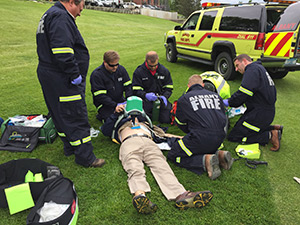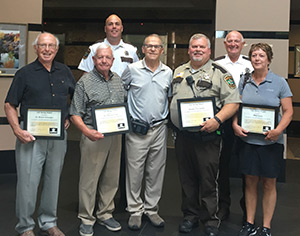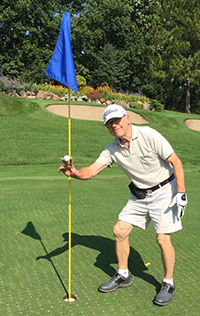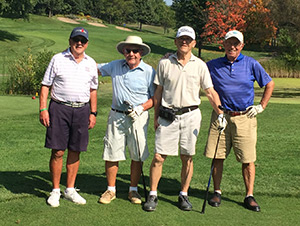Steve B's Story
Heart & Vascular Care“Steve was enjoying a round of golf at Albany Golf Club with three good friends, something he'd done hundreds of times before over the years. He was driving the cart toward his ball for his third shot on the 18th hole when suddenly he froze up and collapsed.”
Heart Attack Survivor Saved by His Family's Generosity
You can call it good karma or divine intervention. Either way, a Central Minnesota man who gives back to his community finds himself the recipient of his own good deed.
In 2001, the Blattner Family Council, founding family of Blattner Energy of Avon, made the conscious decision to convert the company's annual golf outing from an employee celebration to a community fundraiser.
"They wanted to do something to give back to the community," said Steve Blattner, age 77.
The funds raised over the years have enabled the fire departments of Avon and Albany to acquire vital rescue equipment. One such item was the LUCAS® chest compression system, which provides mechanically-controlled chest compressions to a patient suffering sudden cardiac arrest, ultimately improving chances for a good outcome.
Now fast forward to the early afternoon of Wednesday, May 24, 2017. Steve was enjoying a round of golf at Albany Golf Club with three good friends, something he'd done hundreds of times before over the years. He was driving the cart toward his ball for his third shot on the 18th hole when suddenly he froze up and collapsed.
Tom Cress, MD, a retired pediatrician and fellow golfer, immediately knew something was wrong. Dr. Cress conferred with Dr. Robert Schwegler, a retired dentist who was also part of the foursome. They suspected that Steve was having a heart attack and immediately began CPR. They also called the clubhouse and requested that the automatic external defibrillator (AED) be brought out to the 18th hole. With the help of Stearns County Deputy Troy Jansky, who rushed to the scene from his home (the Albany Police Department was unavailable due to another call), the three used the AED to resuscitate Steve and bring his heart back into rhythm.
 First responders using the LUCAS device on Blattner
First responders using the LUCAS device on BlattnerShortly thereafter, first responders arrived with advanced equipment. A key item in their treatment arsenal was the LUCAS device, the very same type of device that was made available to local rescue squads over the years because of Steve's company's generosity.
The next bit of good fortune occurred in the ambulance, where specially trained paramedics followed the CentraCare Heart and Vascular Center STEMI protocol to decide what to do next. The STEMI protocol is a system that allows paramedics to interpret EKGs while they're in the field so they can determine if someone's having a heart attack. If it's apparent that the patient is having a heart attack, they're empowered to transfer them directly to a hospital with a cath lab, potentially saving crucial time by bypassing closer hospitals that are not equipped to handle such emergencies.
"We have trained many of our paramedics to make the call and transfer the patient directly to the cath lab, even bypassing the emergency room here at St. Cloud Hospital," said Daniel Tiede, MD, an interventional cardiologist at CentraCare who met Steve when he arrived at the hospital. The STEMI program at CentraCare Heart & Vascular Center is the most active and efficient in Minnesota, and it was one of several factors that ultimately helped save Steve's life.

Stearns County Sheriff Don Gudmundson and Lieutenant Vic Weiss presented life-saving awards during the Stearns County Board of Commissioners meeting on July 11, 2017. Pictured from left Dr. Robert Schwegler, Dr. Tom Cress, Lieutenant Vic Weiss (back), Steve Blattner, Sr. Deputy Troy Jansky, Mary Lauer and Stearns County Sheriff Don Gudmundson.
Once at the hospital, an angiogram was performed to determine which of Steve's heart arteries were blocked.
"We found that Steve had a critical blockage of the main artery in the front part of the heart called the left anterior descending artery, commonly known as the widow-maker lesion," said Dr. Tiede. He was able to open the blockage with a balloon and placed two stents that restored the blood flow to Steve's heart.
Steve was then transferred to the coronary care unit where he underwent a cooling protocol designed to minimize brain swelling and long-term brain damage. On Saturday, three days after the heart attack, Steve woke up and began talking with his wife. It became clear that his brain did not suffer any lasting damage.
Residual damage to Steve's heart required that he undergo placement of an automatic Implantable Cardiac Defibrillator (ICD) to help protect him from further heart irregularities. That care was provided by Moustapha Atoui, MD, an electrophysiologist at CentraCare.

Steve Blattner cards a hole-in-one
Unlike his heart, however, Steve himself hardly skipped a beat. Two weeks after his heart attack, he resumed golfing. And three months later, while he was golfing with the same foursome at the same golf course where he suffered a near-tragedy, Steve shot his first hole-in-one on the 11th hole. His good fortune, it seems, continues.
Steve looks back on the whole experience with gratitude.
"I have no recollection of what happened, but I know that I had a lot of angels looking after me. Everyone did everything they could to help," he said.
Whatever forces of destiny may have been at work, everything certainly fell into place. At a time when every minute of delay had the potential to cause permanent damage to his heart and brain, any hiccup in the chain of events that took place could have jeopardized a successful outcome. Had Steve not had fellow golfers on the green who knew exactly what to do, had the Albany rescue squad not arrived so quickly (and with equipment Steve's company helped finance), and had the ambulance not taken him directly to St. Cloud Hospital where the artery was immediately opened in the cath lab, things almost certainly would have turned out differently.
The idea that an act of goodwill toward others can ultimately come back in such a life-giving way is reaffirming and uplifting. It's a concept that's alive and well in Central Minnesota.
